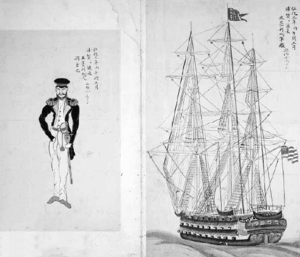 USS Columbus
| |
| History | |
|---|---|
| Name | USS Columbus |
| Builder | Washington Navy Yard |
| Launched | 1 March 1819 |
| Commissioned | 7 September 1819 |
| Decommissioned | March 1848 |
| Fate | Scuttled, 20 April 1861 |
| General characteristics | |
| Tonnage | 2480 |
| Length | 191 ft 9 in (58.45 m) |
| Beam | 53 ft 5 in (16.28 m) |
| Draft | 25 ft (7.6 m) |
| Complement | 780 officers and men |
| Armament | 68 × 32-pounder (15 kg) guns, 24 × 42-pounder (19 kg) carronades |
USS Columbus was a 92-gun ship of the line in the United States Navy. Although construction of the warship was authorized by Congress on 2 January 1813, the burning of the Washington Navy Yard by the Americans in 1814 just prior to the British occupation of Washington, intended to keep US military stores out of enemy hands, led to the destruction of any initial framing.[1][2] Days after Congress re-authorized the vessel on 29 April 1816,[3][4] a keel was laid and construction resumed.[1]
Columbus was launched on 1 March 1819 into the Anacostia River at the Washington Navy Yard; her dimensions were "191 feet 10 inches, between perpendiculars; breadth of beam from outside to outside, 53 feet 6 inches".[1] The warship was commissioned on 29 November 1819, Master Commandant John H. Elton, commanding.[1] Her original armament comprised "92 guns: 68 long 32-pounders and twenty-four 42-pounder carronades";[1] this was greater than the Naval artillery equipping most of the nine ships-of-the-line authorized by Congress in the 1816 legislation, which specified that these warships "rate not less than seventy-four guns each".[1][3]
Enslaved laborer and diarist, Michael Shiner, documented the launching thus, "The United States Ship Columbus 74, constructed and built by Colonel William Doughty and launch on 4 March 1819 on Monday at Washington Navy Yard the United States Ship Columbus 74."[5]
- ^ a b c d e f "American Ships-of-the-Line – Columbus". DANFS Online. Dictionary of American Naval Fighting Ships. Washington D.C.: Naval Historical Center. 1959–1991. Retrieved 1 August 2022.
- ^ Roosevelt, Theodore (1902). The Naval War of 1812, or the History of the United States Navy during the Last War with Great Britain, Part II. New York, NY: G.P. Putnam’s Sons. pp. 45–47. Retrieved 2 August 2022.
On August 20th, Major-General Ross and Rear-Admiral Cockburn, with about 5,000 soldiers and marines, moved on Washington by land… Ross took Washington and burned the public buildings; and the panic-struck Americans foolishly burned the Columbia, 44 [NB: different from the future Columbus, 74], and Argus, 18, which were nearly ready for service.
- ^ a b Sharswood, George, ed. (1839) [1816]. "Chap. 138. An act for the gradual increase of the navy of the United States.". The Public and General Statutes Passed by the Congress of the United States of America: From 1789 to 1836 Inclusive (2nd ed.). Princeton University, via Google Books: T. and J.W. Johnson. p. 1598.
Sect. 2. That the president of the United States be, and he is hereby, authorized to cause to be built nine ships, to rate not less than seventy-four guns each, and twelve ships, to rate not less than forty-four guns each, including one seventy-four [i.e., Columbus] and three forty-four gun ships, authorized to be built by an act, bearing date on the second day of January, one thousand eight hundred and thirteen, entitled, "An act to increase the navy of the United States.
- ^ Gordon, John Steele (February 1993). "USS Boondoggle: The Business of America". American Heritage. 44 (1).
- ^ The Diary of Michael Shiner Relating to the History of the Washington Navy Yard 1813-1869 transcribed and edited by John G. Sharp, 2007, 2015,,Naval History and Heritage Command, Washington, D.C. https://www.history.navy.mil/research/library/online-reading-room/title-list-alphabetically/d/diary-of-michael-shiner/1813-1829.html#17
© MMXXIII Rich X Search. We shall prevail. All rights reserved. Rich X Search
